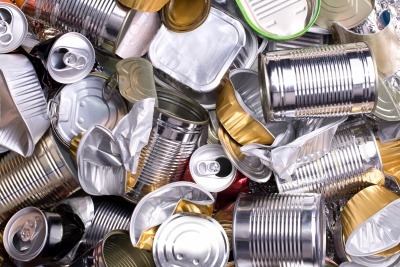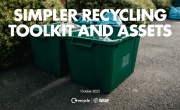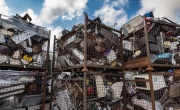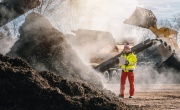Maximising aluminium recycling in the face of new legislation
Tom Giddings, Executive Director of Alupro, tells Resource how the aluminium industry might overcome new challenges presented by the introduction of Extended Producer Responsibility (EPR) and the Deposit Return Scheme (DRS).
Q - Hello Tom. Lovely to meet you. Let’s maybe kick things off with an overview of what Alupro is concentrating on right now…
 Alupro started off in the early 90s, and it was an early industry effort to get recycling rates up, because there is an economic as well as a social and environmental case for recycling, especially for aluminium. When we started, the focus was on Cash for Cans, but today is a completely different kettle of fish and our work encompasses the entire value chain.
Alupro started off in the early 90s, and it was an early industry effort to get recycling rates up, because there is an economic as well as a social and environmental case for recycling, especially for aluminium. When we started, the focus was on Cash for Cans, but today is a completely different kettle of fish and our work encompasses the entire value chain.
We operate around three big pillars. Firstly, we've got the public affairs part of it, which is all about supporting our members on wide-ranging topics such as responsible sourcing, carbon footprints, recycled content, through to the deposit return scheme – really being the voice of the industry. Then, our middle pillar is the core of what our team does, which is bringing the public along. We can talk technical all day, and I quite often do, but what we're most valued for, and where our core competencies lie, is running consumer engagement programmes through partnerships to really ram home the message of ‘recycle your aluminium. It's easy to recycle, just do it’.
That's been going on for 10 years now and our longest-running programme is Metal Matters, which we run in collaboration with councils and local authorities to promote curbside recycling of all metal.
Lastly, we think about the future with an eye on the consumers of tomorrow. We've got a school education programme, with downloadable curriculum-linked resources, plus we sponsor competitions with prizes to teach them about recycling not just aluminium but in general.
Q - That’s a broad remit. And what do you think it will take to get the aluminium recycling rate closer to 100 per cent?
 The reason that we are so focused on consumer communication is that we do believe that is probably the key factor, and that it is equally as important as the reform of the system that is going on at the moment. One of the things we've been disappointed about when looking at extended producer responsibility or consistent collections is that while it's important to know how investments in the packaging recycling sphere go back into the infrastructure to make sure everything is sorted, they don't mean anything if you don't get the supply of material in from the consumer. You can optimise the system all you like, but if you don't get yields up, you're dead in the water.
The reason that we are so focused on consumer communication is that we do believe that is probably the key factor, and that it is equally as important as the reform of the system that is going on at the moment. One of the things we've been disappointed about when looking at extended producer responsibility or consistent collections is that while it's important to know how investments in the packaging recycling sphere go back into the infrastructure to make sure everything is sorted, they don't mean anything if you don't get the supply of material in from the consumer. You can optimise the system all you like, but if you don't get yields up, you're dead in the water.
And just by way of context, we're not in a bad place now – 68 per cent overall recycling rate for aluminium packaging and 82 per cent with beverage cans. So we haven't got that much further to go to get to the current 90 per cent plus, which is where we would want to be for beverages.
Q - Have you identified a sweet spot demographic that may have the biggest impact if you could win them over?
The younger groups (25-to-34s and the 16-to-24s) were the least knowledgeable around good recycling practices, but they consume the most cans per capita. ‘Every Can Counts’ focuses on the 18-to-44 age bracket, and that's why we're at festivals, Formula One and those types of events.
Q - From the results of your surveys, what have you seen as being the major barriers or opportunities to increase those recovery rates from the public?
We see aerosols and foil as being an area of focus that needs to be addressed over the next five years or so. Aerosols consistently top WRAP’s confusing consumer packaging survey. People are not sure what to do with half-empty aerosols and not sure what to do with the ones that are full. And that's before they think about the plastic lid, the plastic valve and all other kinds of bits and bobs. Foil is easy to recycle, it's just aluminium. But what is what people aren't sure of is ‘do I wash it?’. For us, it's always ‘rinse, scrunch, recycle’ – keep it simple.
Q - So, aerosols. Tell us more.
Absolutely. It's my passion project at the moment. I start there, because it bleeds into the bigger aspects of EPR. And we are talking about millions of units, if not billions of units; thousands of tonnes of aluminium, which is very important for us to be able to harness and put back into the circular economy.
 The long and short of it is that I'm worried that aluminium – for all its potential – is going to get left behind by EPR, particularly when you strip out beverage cans through a deposit return scheme. You're left with ‘the left behind materials’ – that's our term for aerosols, foil, tubes – everything that's in your recycling bin after a deposit return scheme takes the cans.
The long and short of it is that I'm worried that aluminium – for all its potential – is going to get left behind by EPR, particularly when you strip out beverage cans through a deposit return scheme. You're left with ‘the left behind materials’ – that's our term for aerosols, foil, tubes – everything that's in your recycling bin after a deposit return scheme takes the cans.
As soon as DRS and EPR started to evolve we saw that we needed to think about non-beverage. The Government doesn't seem to really know what it's doing in that respect – in terms of understanding the scale of the problem, or even the size of the market. So we need to step in and provide that data.
So we started off with aerosols as it seemed to be that aerosols faced the biggest potential challenges around recyclability, with different materials being present and the potential for hazardous waste. They're made of almost pure aluminium or steel with immense Circular Economy potential.
We worked with Resource Futures – a consultancy based in Bristol. Nearly 90 per cent of the aerosols that they found, regardless of whether they were in the residual waste or not, were empty. But we found that only half of the aerosols were coming through in the recycling – across the ten sample areas – which was disappointing because that means we've only got half entering the right stream. So we need to get substantially higher on that.
We are also having a look at what was going into recyclers and we could be looking at a recycling rate that is substantially higher than the previous estimate of two per cent. I'd say we're looking at well over ten times that.
We need to optimise the system so that we can tell consumers exactly what we want them to do. The idea is to get ahead of EPR.
Q - And when you say about the system change, what sort of changes do you mean?
We need to make sure that there are safe operating procedures for the material recycling facilities (MRFs). We want to make sure that there is efficiently deployed technology for them to handle it. You know, do we have degassing bailers – all that type of thing – the technology is out there.
It's about making sure that we are optimising the flow of aerosols to those people able to handle them. Because what that creates is a more desirable product for the recyclers to buy.
Q - Is there scope for separate collections of aerosols? Is that what you’re hinting at?
It's been considered but deprioritised, I think would be the term for it. It's not something I want to explore as a priority simply because I think there are better ways of doing it.
We could see an aerosols DRS in the future. You should never discount anything. But our preference would be to use the curbside schemes that we've got. We know the MRFs can handle them and there is a sustainable and healthy demand from producers to put reycled content in their products. Several pieces are missing so we need to sort that so there is a nice flow through the system.
Q - Is the aluminium recycling rate going to go through a bit of a roller coaster ride, if more virgin material is extracted to increase the availability of fully recyclable material?
You've touched on what is a very live wire at the moment, which is the degree to which you can facilitate recycled content within the products. So, somewhere in the region of a third of the aluminium used in Europe is recycled content and the rest of it is virgin. That's for buildings, cars, aeroplanes and packaging. The ambition for Europe is to have a 50:50 split by 2050 and the reason it's not more ambitious is exactly as you say – that demand is outpacing growth.
So one of the things that we're advocating for when it comes to deposit return schemes, and the reason we think this is a good idea, is because it collects that material and makes sure that it goes back into the packaging loop. It's sold to whoever wants to recycle it, but it has to go back into cans because there's a huge demand for recycled aluminium packaging.
Q - So, it really is about recycling rates?
Put it this way: we can talk about recycled content all day long, but unless you have a good end-of-life recycling rate from the products on the market, you'll never get to a circular economy. So your KPI really is recycling rate. Once that's 90 per cent plus, then we'll worry about where it's going. But let's get it recycled first, that is the priority.
Q - What about pricing trends for packaging recovery notes?
There was a consultation last year on how to reform the PRN system to its eventual death around 2027. We were very disappointed that a lot of the more pragmatic changes that could have reduced, for example, market volatility, were missed in terms of what was taken on from the consultation.
But you know, ultimately, there were some positive things that were taken. One of my frustrations with the PRN system is that it’s not transparent. You can't identify exactly what's going on because the different actors are charging you different values for your PRN – there are commercial factors at play. But this seems to be calming down now.
January 2023 saw decent recycling levels, certainly in line with what we saw last year, so I'm expecting a smooth 2023. Part of our role is to keep an eye on the PRN market for our members and to calm it down. There is a huge demand for recycled aluminium packaging and the recyclers will buy anything they can get. So there's no shortage and, looking at the size of the market which has only grown double digits percentage over the last couple of years, supply is plentiful.
Q - Any concluding thoughts?
The other big issue for us is deposit return schemes. We're at an exciting point with that. We've had the government response and there are parts that we're happy with but there are vast tracts of it that we're not.
There are a couple of key factors in that – if the industry is going to fly for the next five to ten years and not take a big hit from unintended consequences – must be included in the thinking in the next 18 months. Otherwise, we're risking severe damage to the market.
There are definite opportunities around recognising the role of consumer education, making sure there's a fair and level playing field across all the competing materials, and making sure there's a circular economy. DRS is not just an anti-litter thing, it is a recycling mechanism.
Making sure that all these things are included in the philosophy of what's going to be implemented is going to be key to its success.









